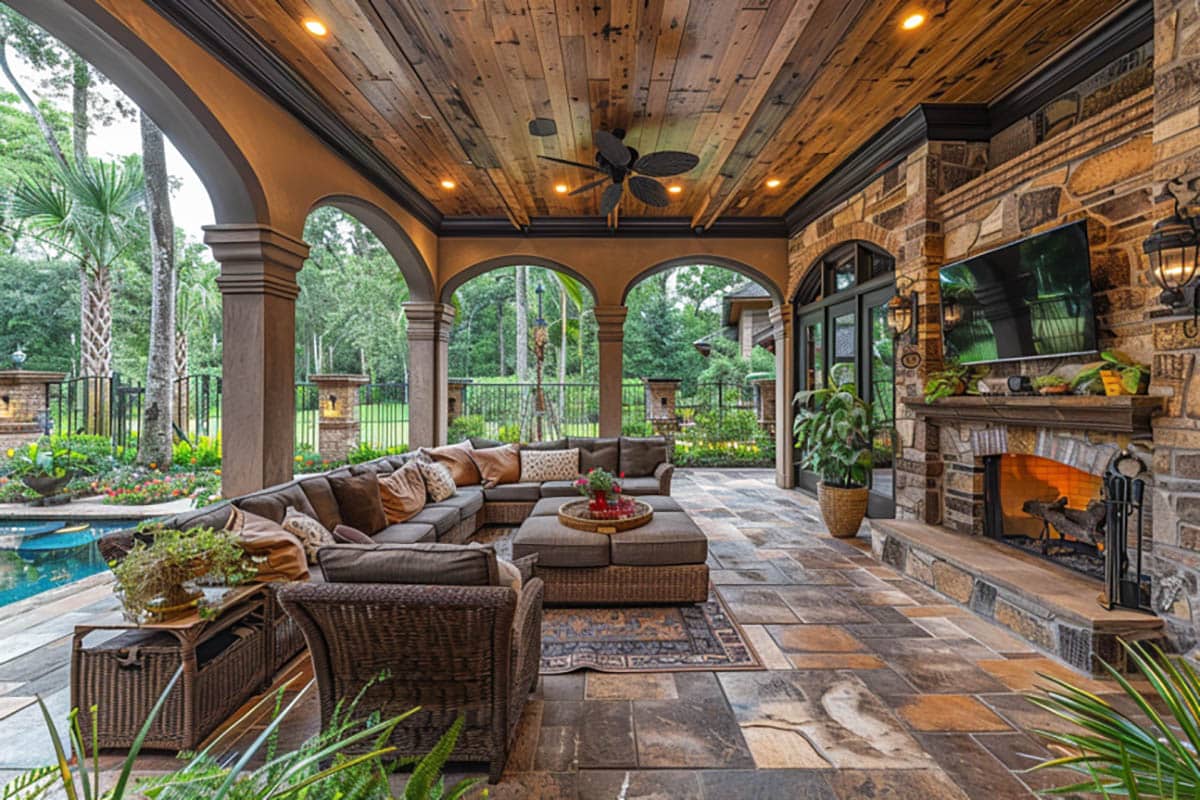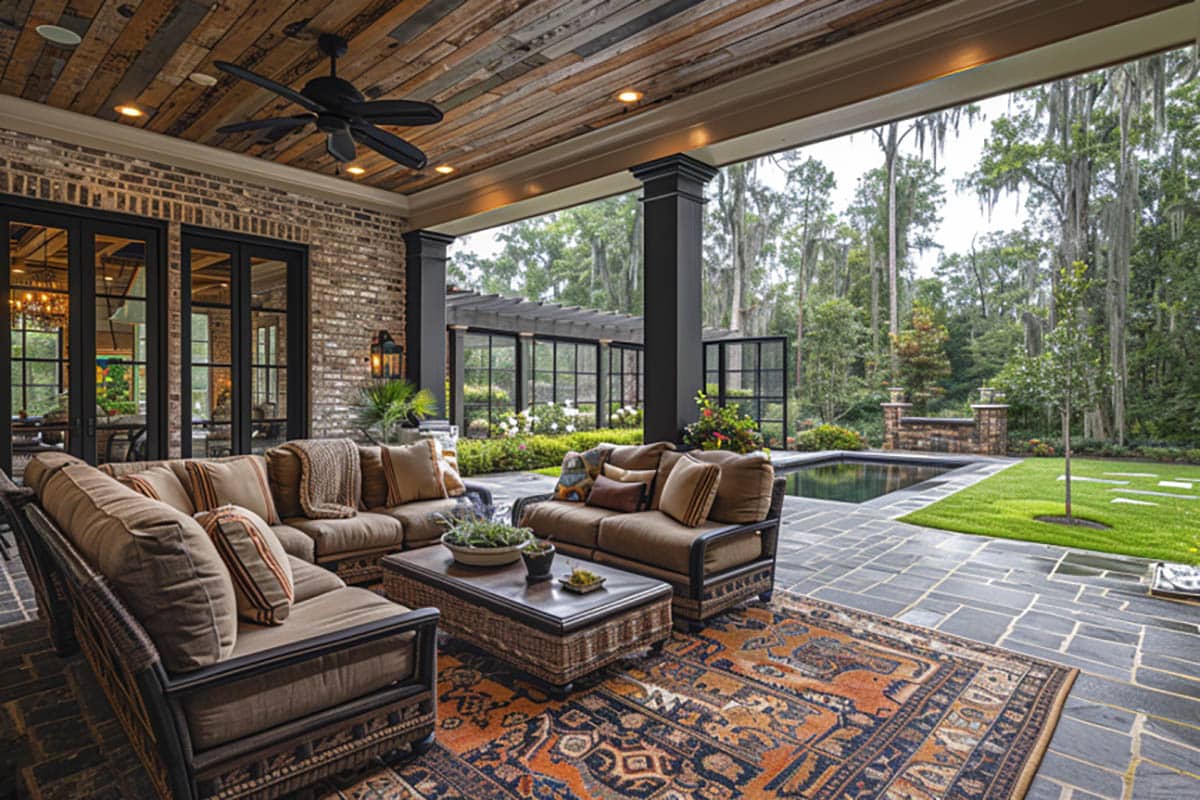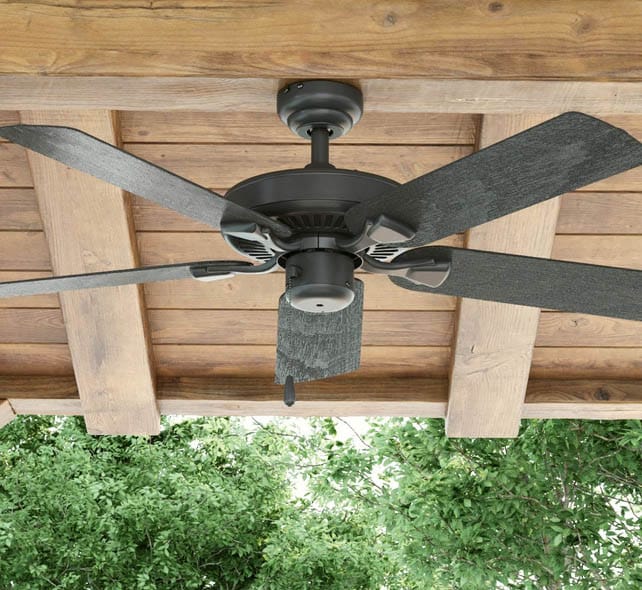What Size Ceiling Fan For An Outdoor Patio?

The outdoor patio is one of the most underrated spaces in a modern home. Yet, three in four Americans love to relax in this section, while three in five turn the patio into a socialization venue. Unfortunately, spending time on the patio during the summer can be excruciatingly unpleasant. An appropriately sized ceiling fan should keep this place cool and comfy. But what size ceiling fan for outdoor patio should you get?
Recommended Fan Sizes for Different Patio Sizes
As mentioned, ceiling fans for outdoor patios come in various sizes for optimum airflow and cooling. You don’t want the feature to be merely an ornament beautifying the patio. Homeowners want functionality to keep them comfortable during the summer.
The following table summarizes ceiling fan size recommendations grouped into square footage.
| Patio Floor Area | Recommended Fan Size (Blade Diameter) |
| Less than 50 square feet
(4.6 square meters) |
Up to 29 inches
(74 centimeters) |
| 50 to 75 square feet
(4.6 to 7 square meters) |
29 to 36 inches
(74 to 91 centimeters) |
| 75 to 100 square feet
(7 to 9.3 square meters) |
36 to 42 inches
(0.81 to 1.1 meters) |
| 100 to 225 square feet
(0.3 to 21 square meters) |
42 to 52 inches
(1.1 to 1.3 meters) |
| 225 to 400 square feet
(21 to 36 square meters) |
56 to 62 inches
(1.3 to 1.6 meters) |
Please note these recommendations reflect enclosed space. Hence, these measurements should be perfect for outdoor patios with four closed walls. However, patios with open sides require a different fan size.
Open sides don’t keep air within the patio, mostly dissipating into the surroundings. Such scenarios require adjusting the patio floor area by 25%.
For example, a 29-inch-diameter ceiling fan should be sufficient for a 48-square-foot area. However, a 29- to 36-inch unit is more suitable for a patio with open sides (48 square feet x 25% = 12; 12 square feet + 48 square feet = 60 square feet).
Hence, you could always choose a ceiling fan designed for a larger space (50-75 square feet instead of <50 square feet).
Factors to Consider When Choosing a Fan Size

Choosing a ceiling fan for the outdoor patio can be challenging for first-time homeowners and people with limited knowledge of such air cooling technologies. Prospective buyers must consider several factors when shopping for such an appliance. Here are three crucial aspects one must appreciate.
Size of the patio area – Your patio’s size is the single most significant factor influencing its size. Think about it. Would you feel comfortable in a 200-square-foot outdoor space if the ceiling fan circulating air downward and sideward is a 30-inch-diameter unit?
It makes sense. The more spacious the room, the more airflow the ceiling fan must produce to cool the area. And since its diameter correlates with airflow (alongside blade pitch and motor size), larger rooms need larger ceiling fans.
But what if you have a house-sized outdoor patio? Even the largest-diameter ceiling fan installed in the center cannot circulate air and cool the area sufficiently for optimum comfort. Some sections might not receive airflow. A remedy for such instances would be to install several ceiling in strategic locations to promote efficient airflow.
Ceiling height and clearance – Another factor worth considering when buying an outdoor fan is the floor-to-ceiling height. They must be high enough from the floor to push air down and outward, cooling the patio and making occupants feel comfortable.
Experts recommend a ceiling fan height of eight to nine feet for optimum ventilation and space cooling. This measurement spans the floor to the fan’s blades bottom surface, although some installers set the electric appliance about seven feet off the ground. Blades should also be positioned at least 30 inches from tip to the nearest obstruction to avoid injuries.

Some homes have high-ceiling patios, requiring families to connect it to a rod fixed to the ceiling. This setup ensures the fan maintains the ideal height relative to the floor. Too high, and not enough air will reach the patio’s peripheries. Too low, and families risk injuring themselves by hitting their heads on the spinning blades.
The scale of outdoor furniture and the patio layout – Sofas, lounges, and similar furnishings can influence ceiling fan size. These objects are obstacles that prevent air from flowing throughout the patio. Likewise, bulky furniture can reduce the volume of patio space, requiring ventilation and cooling. Smaller furnishings should not pose any concern.
The patio’s layout can also influence size choices. For example, a 60-inch-diameter fan should be enough to cool and ventilate a 120-square-foot rectangular or square patio. Families can install the appliance in the center, and occupants will have a breezy relaxation.
Unfortunately, some patios have irregular or atypical layouts. Some sections are expansive, while others might be narrow. Furnishing locations can also influence its size relative to the patio’s layout.
Solving this riddle requires subdividing the patio’s layout into smaller square or rectangular sections. This tactic allows homeowners to determine each area’s square footage, enabling them to choose the correct fan size. We must emphasize that manufacturers often rate their products based on recommended square footage. One can only achieve this with a traditionally rectangular or square patio layout.
You might want to know that the optimum floor layout for a ceiling fan is circular. Unsurprisingly, gazebos and similar rounded areas make perfect spaces for these.
Types of Outdoor Ceiling Fans

Blade size isn’t the only differentiating attribute of patio fans. These space-cooling appliances also vary in style and wet- or damp- rating. Knowing these characteristics helps homeowners pick the right one for patios.
Wet-rated vs. Damp-rated fans
Weather-proofing is essential to all outdoor appliances. Exposure to the elements can increase the risk of corrosion buildup, dirt-clogging, and motor malfunction due to airborne contaminants.
Water or moisture remains a threat to outdoor fans’ optimum function and operational lifespan. That’s why manufacturers rate their offerings depending on the fan’s ability to withstand the elements, especially moisture.

See this damp-rated fan at Amazon [sponsored link]
Damp-rated fans – As the name implies, they can withstand moisture and humidity or dampness. These appliances aren’t waterproof but feature sufficient protection in a moist environment.
Damp-rated units make perfect choices for porches, patios, and other covered outdoor spaces. These fixtures are also ideal for laundry rooms, bathrooms, and garages. The appliance should work fine, provided it doesn’t contact water directly.
Wet-rated fans – These electric fans are the top-of-mind choice of homeowners with open outdoor spaces, such as cabanas and verandas. The weatherproofing is exceptional, protecting the appliance against water and moisture ingress. It can also safeguard the unit against snow, making it ideal for open spaces.
Wet-rated fans are slightly more expensive than damp-rated options due to advances in weatherproofing. Moreover, manufacturers subject each product to rigorous testing, ensuring it can withstand the elements. The motors are moisture-resistant and often feature advanced surface protection. The fan’s blades are also more durable than damp-rated varieties.
Besides verandas and cabanas, wet-rated fans are also perfect for a gazebo. It’s the perfect appliance for cooling everyone watching the garden with a 360-degree view.
A pergola with three open sides can also accommodate a wet-rate appliance. Having drinks, sharing laughter, or simply lazing outdoors should be fun and comfortable with a wet-rated unit spinning above the head.
Exposed decks can be more comfortable with wet-rated units circulating air. Families will never fret about water, moisture, UV rays, and other elements wreaking havoc on the appliance.
Style Options that can Complement Outdoor Décor
Electric fans can also complement outdoor décor. Here are some styles worth considering to give your patio and similar outdoor spaces a much-needed vibe uplift.
Modern Contemporary – Many modern homes with minimalist features opt for a contemporary ceiling fan style. This appliance has a sleek metallic finish to stay in tune with 21st-century design philosophy. It’s an artistic statement, complementing ultra-modern furnishings and décor.
Traditional – The quintessential ceiling fan features rich metal and wood tones to stay as close to the classics as possible. Symmetry and uniformity are vital, making traditional styles ideal for patios and porches.
Transitional – This style is perfect for homeowners who cannot decide between a modern contemporary and a traditional device. Most transitional units feature smooth lines like contemporary options, except the geometric characteristics are less pronounced.
Tropical – Add a touch of paradise to the patio with a tropical-style unit overhead. Palm tree-like blades can offer a refreshing take to a typical design, giving the outdoor space a more relaxing and unfussy vibe. This design can complement furnishings with orange, yellow, and blue themes.
Restoration Vintage – As the name implies, this style celebrates the old by giving it a new breathe of life. It has a classic design yet as functional as other appliances. Restoration vintage fans complement antique furnishings.
Mid-century Modern – Clean and simple, mid-century (1950s) ceiling fans can transform outdoor spaces into inviting and warm areas perfect for accommodating guests. It’s ideal for outdoor areas with crisp white ceilings and walls.
Rustic – Perfect for metal and glass objects and other décor with hard surfaces. Most rustic fans feature wooden blades to give the patio a more natural look.
References Factors to Consider When Choosing a Size https://www.angi.com/articles/sizing-ceiling-fan.htm https://portacool.com/how-big-should-my-outdoor-patio-fan-be/






